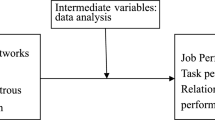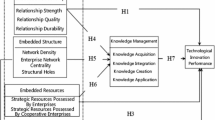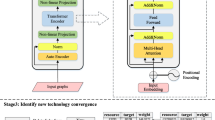Abstract
Enterprise technology alliance innovation is the power force of enterprise development. At present, the enterprise science and technology alliance is affected by many factors in the innovation process. It is difficult to grasp the direction of science and technology innovation in an economic market environment, which has a certain impact on the development of enterprises. Based on the BP neural network model, this study uses relationship embedding and structure embedding in network embedding as predetermined variables and inter-organizational knowledge transfer as intermediary variables to study the internal mechanism of technological innovation capabilities of China’s high-tech enterprise technology alliances. Furthermore, a corresponding model was constructed for simulation analysis, and a valid factor analysis was performed on the valid data with Lisrel 8.70. The results show that network embedding is the power force of enhancing the technological innovation capability of China’s high-tech enterprise technology alliances.













Similar content being viewed by others
References
Kandampully J, Bilgihan A, Zhang T (2016) Developing a people-technology hybrids model to unleash innovation and creativity: the new hospitality frontier. J Hosp Tour Manag 29:154–164
Chaojun Y, Ruoqing HU, Hongjuan Y (2017) Evaluation of technology innovation performance of manufacturing based on PPE-Malmquist–LWM model. Ecol Econ 33(11):67–72 (in Chinese)
Liyong W, Chuanhui H, Education SO (2016) Influencing factors and model for the regional science and technology innovation resources sharing: a research based on theories of path dependence and innovation diffusion. J Intell 35(01):182–187 (in Chinese)
Briones-Peñalver AJ, Bernal-Conesa JA, Nieto CDN (2019) Knowledge and innovation management model. Its influence on technology transfer and performance in Spanish Defence industry. Int Entrep Manag J 16(1):1–21
Saji BS, Ellingstad P (2016) Social innovation model for business performance and innovation. Int J Prod Perform Manag 65(2):256–274
Mejiatrejo J, Sanchezgutierrez J, Gonzalezuribe EG (2016) Business model, customer needs and innovation management: proposal of a conceptual process for competitive improvement. Social Science Electronic Publishing
Hongzhuan C, Yue W, Lulu S et al (2018) Modeling analysis of complex products resource integration behavior under distributed collaborative technology innovation mode. J Syst Sci Inf 6:214–236
Chen H, Wang Y, Song L et al (2018) Modeling analysis of complex products resource integration behavior under distributed collaborative technology innovation mode. Nephron Clin Pract 6(3):214–236
Gallos P, Minou J, Routsis F et al (2017) Investigating the perceived innovation of the big data technology in healthcare. Stud Health Technol Inform 238:151
Howard SK, Thompson K, Yang J et al (2017) Working the system: development of a system model of technology integration to inform learning task design: developing the system model. Br J Educ Technol 50(1):326–341
Holland DD (2016) High-trust leadership and blended learning in the age of disruptive innovation: strategic thinking for colleges and schools of education. J Leadersh Educ 15:74–97
Dapeng Y, Songting P, Ning C (2016) Enterprise innovation and entrepreneurial strategy development in perspective of positive organizational behavior. J Comput Theoret Nanosci 13(12):9353–9357
Yu W, Wen-Xing S (2016) Study on innovation model of agricultural transgenic biological technology. J Biol 3(02):86–90 (in Chinese)
Wei-Ping J, Rui-Wen JI, Wen-Long H (2016) Construction of dynamic model on influencing mechanism of technology innovation alliance to enterprise’s technological performance based on the network embeddedness perspective. Chin J New Drugs 25(20):2294–2300 (in Chinese)
Weibai L, Zhong L (2016) On the option game model of the investment decisions for radical technology innovation in enterprises. Manag Rev 28(04):89–97 (in Chinese)
Angelidis P, Berman L, Celi LA et al (2016) The hackathon model to spur innovation around global mHealth. J Med Eng Technol 40(7–8):392–399
Jie D, Xianjun H (2016) Knowledge spillover effect on technology innovation in Guangdong Province based on spatial measurement. J Shenzhen Univ(Sci Eng) 33(4):367
Yunfei S, Kun Z, Yanbo W (2017) Breakthrough technology innovation: literature review and prospect. Technol Econ 36(04):30–37 (in Chinese)
Fan IYH, Lee RWB (2016) Intellectual capital-based innovation planning: empirical studies using wiNK model. J Intellect Cap 17(3):553–569
Leydesdorff Loet, Ivanova Inga (2016) “Open innovation” and “triple helix” models of innovation: can synergy in innovation systems be measured? J Open Innov Technol Mark Complex 2(1):11
Pollock D (2017) Development and testing of a model of interactive innovation adoption in health care. Proc Assoc Inf Sci Technol 54:778–780
Author information
Authors and Affiliations
Corresponding author
Ethics declarations
Conflict of interest
The authors declare that they have no conflict of interest.
Additional information
Publisher's Note
Springer Nature remains neutral with regard to jurisdictional claims in published maps and institutional affiliations.
Rights and permissions
About this article
Cite this article
Sang, B. Innovation of enterprise technology alliance based on BP neural network. Neural Comput & Applic 33, 807–820 (2021). https://doi.org/10.1007/s00521-020-05254-2
Received:
Accepted:
Published:
Issue Date:
DOI: https://doi.org/10.1007/s00521-020-05254-2




